Some people think that until the last turn of the century, BMW built pretty stodgy motorcycles that were good for the touring rider, but rather weak on performance. To a degree that is true, but back in the ’30s, Bavarian Motor Works was as much a pioneer of innovation as it is today.
In 1935, BMW came out with hydraulically damped telescopic forks, the first in the industry, and in 1938 it put a spring frame, plunger variety, on a production bike. In 1939, BMW riders took first and second place at the Isle of Man Senior TT.
Then all hell broke loose in the form of World War II. And when it was over, Germany was pretty much in smithereens and the Allies were calling the shots. One shot was aimed at BMW, whose factory near Munich had survived more or less intact but was not allowed to resume motorcycle production. However, by 1947 these restrictions had eased, allowing motorcycles up to 250cc in size to be built, and the factory went out scavenging for material to build them.
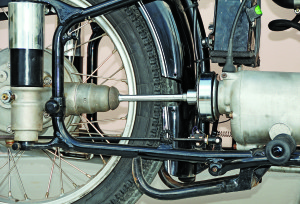
Europe had become a motorized continent in the 1930s and, following the war, people clamored for personal transportation, whether it was to get to work, go shopping or visit the relations. There was nothing remotely sporty about most of these post-war vehicles—they were just basic conveyances.
The R24 subsequently appeared in March of 1948 at the Geneva, Switzerland, auto show. Why R24? Because the last pre-war 250 had been labeled an R23. The R24 was powered by a 250cc single-cylinder OHV engine, rather like one the company had been building in the ’30s, with a perfectly square bore and stroke of 68mm set vertically on an alloy crankcase. A 22mm Bing fed the very low-octane gas available at the time into the combustion chamber, where it was compressed a modest 6.75 to 1. The frame was made of bolted-together pressed-steel pieces, having no rear suspension, with an undamped telescopic fork at the front. A new 4-speed gearbox was included and, of course, shaft drive…a BMW feature since the first Beemer rolled off the line in 1923.
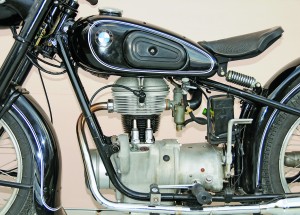
It took a while to get into production, and the first R24 rolled off the line in December of that year, weighing less than 300 pounds with a gallon of gas in the tank. Less than 18 months later, the R25 appeared. The most notable difference being the welded steel twin-loop tubular frame and a plunger-style rear suspension. In 1949, the Allies dropped the under-250 requirement and the next year BMW presented the 500cc R51/2—the /2 added because there had been an R51 before the war. However, the factory was building two 250s for every 500 because the little single was the brot und butter for the company.
The R25/2 appeared in 1951 with minor changes, mostly to the sheet metal and also to the suspension of the solo saddle, followed by the R25/3 that came on the market in 1953.
The /3 was an all-around better motorcycle, nothing radical but with slightly more power and improved suspension. The fork now had hydraulic damping, with a manual steering damper up at the steering head. The gas tank was redesigned, with a lockable toolbox built into the side—more aesthetic than the previous model’s top-of-tank toolbox. A small carrying rack could be mounted on the tank, a popular item for the functionally minded.
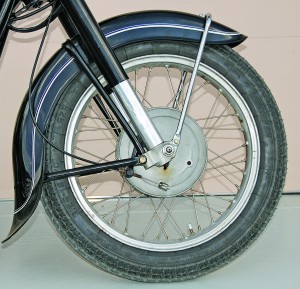
Minor work had been done on the engine, notably an increase in the compression ratio to 7:1—thanks to improved octane rating in the gasoline. This upped the ponies from 12 to 13 at a respectable 5,800 rpm, and a crouched rider on a solo machine could see 75 mph (or 120 kph) on the speedometer. No tachometer here. There was also improved breathing through the 24mm Bing carburetor. Ignition was via a 6-volt battery and coil, with a Norris generator providing constant spark and lights.
Lubrication was via a wet sump, with a submerged pump, using force-feed and splash to make sure the oil got everywhere it was supposed to. There were actually three separate places requiring oil—the engine, transmission and rear end—so a thorough check required a bit of time. When the driveshaft got enclosed on the R26, that was a fourth place to check.
A single-plate clutch put the power through a 4-speed gearbox, and the solo outfit with three gallons of gas in the tank weighed in at 350 pounds. The wheel rims were now alloy rather than heavier steel, both identical 18-inchers—interchangeable—with 3.25 tires. The brakes were of the single-leading shoe variety, 160mm in diameter, mounted in full-width hubs. The wheelbase of the R25/3 was almost 54 inches.
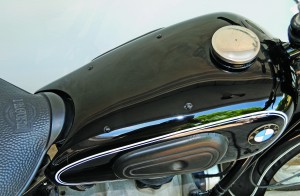
As an indication of two-wheel popularity, BMW claimed to have produced 100,000 motorcy-cles be-tween 1948 and 1953, the 250s, 500s and 600s. Much of this was due not to enthusiasm, but to the fact that inexpensive cars were just not readily available. R25s, as well as the bigger twins, were a little late getting to the United States, as it was not until 1954 that Butler & Smith began importing the marque.
As an aside, I should mention that back in the early ’50s cars were difficult to find in Germany, and sidecars were a useful and popular way to enhance the carrying capacity of a motorcycle. Many motorcycles came with attachment points built into the frame, as did all BMWs. The BMW factory sold a matching sidecar, called the Sidecar Standard, made by the Steib company, which at that time was building 50 sidecars a day. With the Standard, all three wheels were the same so the rider could carry a fourth on the back of the sidecar as a spare.
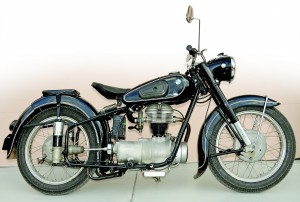
The Standard was a very light sidecar, weighing about 100 pounds, with a very thin metal body and a leather seat. Today, a 250 outfit would be considered an oddity, especially with 13 horsepower, though it would be perfect for getting the groceries or taking the dog for an outing; maybe both together. With today’s highway speeds, such a rig would be best suited for town work and back roads, as the factory advertised its top speed at 54 mph.
Over its six-year run, BMW sold over 45,000 of the R25s, but time and technology wait for no man. Come 1956, the R25 became the R26, with an Earles fork front suspension and a swingarm rear. But the small-motorcycle boom was passing, and though BMW kept a 250 in the line until 1967, it never sold as well as the R25.
Sixty years later, BMW is still making motorcycles, though none as small as a 250, and Steib is still making sidecars.
(This Retrospective article was published in the January 2013 issue of Rider magazine.)








I have my owned R25/3 BMW .I want same parts pl help me.
I have an original R25 Tank for sale
bobmag922@gmail.com
I bought a 1953 R25 (or was it R-250?) in Greece in 1968 and owned it for two years. I loved that machine and was sorry to have to sell it. I paid 5000 drachmas (about $170) for it, but it cost 8000 drachmas in import duties and taxes in order to get a Greek license plate!
I am looking for a running condition with a valid license R23/R25.
Will export it to Israel.
Yair i have 1954 R25/3 i orignal condition that runs great. I am in Belgrade Serbia. Price 3000E. Has all papers for export.
Thank you very much Sir but I have decided to postpone the purchase for while.
Best regards, Y.M.
This is my story. About 20 years ago I visited my family in Corfu Greece. I ask around the village if any one knows some one that owns a BMW with a side car. The word spread around and a bike was located in Episkopi Klimatia suburban. I visited the Gentleman name George at his little home in Episkopi sat down with him and talked about the bike, 1953 R 25 -3 I believe it is. Mr. George told me that the BMW wasn’t for sale however next time you visit you family and come from America come to visit me and then we can talk about it.
My wife and I visited our village Klimatia almost every year remodeling our home and I really never forgot George but in the back of my mind always I wanted to stop by to see him.
This year on the 13 September 2017 I did stop by to see the old home and see if the bike was still there. To my surprise the R 25 was in one side of the room and the side car in another corner, O M G this is a truly barn find.
To make the long story short, George passed 7-8 years ago, I found the son through his and that lives in a near by Village call him and make a deal. The Bike is in my storage at my home in Klimatia . I love to find some one to restore it in memory of George. Any help will be greatly appreciated.
Thank you all.
Constantine Los Angeles California.
I have a friend who could restore the bike for you.
I’ve found bmw 25/3 .
..and now is looking some parts of engine head.
What a lovely story. That bike clearly meant the world to George and it is entirely fitting that it should find its way to the man who sought it out, appreciated its importance and will remember George fondly as he enjoys riding the old outfit just as he did.
The distinguishing mark of the R25/3 is the black head and black valve caps. It is missing on the pictures.
Since engine number 263051 (R25/2) it came with a black called “Mohrenkopf” and a heat conductive gasket.
Older R25 were upgraded when they came to a work shop for service.
Where May I buy a new original carburetor for a R25?